Irish wolfhound
The Irish Wolfhound is a historic sighthound dog breed from Ireland that has by its presence and substantial size inspired literature, poetry and mythology.[4][5][6] Like all sighthounds, it was used to pursue game by speed; it was also famed as a guardian dog, specializing in protection against and for the hunting of wolves. The original dog-type was presumed extinct by most knowledgeable authors but recreated specifically for the canine fancy mainly by Captain George A. Graham in the late 19th century[7][8] The modern breed, classified by recent genetic research into the Sighthound United Kingdom Rural Clade,[9]:Fig. S2 has been used by coursing hunters who have prized it for its ability to dispatch game caught by swifter sighthounds.[10][11]
| Irish Wolfhound | |||||||||||||||||||||||||||||||||
|---|---|---|---|---|---|---|---|---|---|---|---|---|---|---|---|---|---|---|---|---|---|---|---|---|---|---|---|---|---|---|---|---|---|
_Irish_Wolfhound_4.jpg) | |||||||||||||||||||||||||||||||||
| Origin | Ireland | ||||||||||||||||||||||||||||||||
| |||||||||||||||||||||||||||||||||
| |||||||||||||||||||||||||||||||||
| Notes | Unofficial national dog breed of Ireland | ||||||||||||||||||||||||||||||||
| Dog (domestic dog) | |||||||||||||||||||||||||||||||||
History
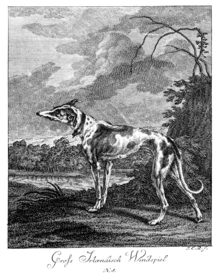
Maybe the earliest image of an Irish Wolfhound.[12]
.jpg)

Pre-19th century
In 391, there is a reference to large dogs by Quintus Aurelius Symmachus, a Roman Consul who received seven "canes Scotici" as a gift to be used for fighting lions and bears, and who wrote "all Rome viewed (them) with wonder".[13] Scoti is a Latin name for the Gaels (ancient Irish).[14] Dansey, the early 19th century translator of the first complete version of Arrian's work in English, On Coursing, suggested the Irish and Scottish "greyhounds" were derived from the same ancestor, the vertragus, and had expanded with the Scoti from Ireland across the Western Isles and into what is today Scotland.[15]
The dog-type is imagined by some to be very old. Wolfhounds were used as hunting dogs by the Gaels, who called them Cú Faoil[16][17] (Irish: Cú Faoil, Irish pronunciation: [ˈkuː ˈfˠiːlʲ] "hound"[18] of "wolf"[19] or wolfhound). Dogs are mentioned as cú in Irish laws and literature dating from the 6th century or, in the case of the Sagas, from the old Irish period, AD 600–900. The word cú was often used as an epithet for warriors as well as kings, denoting that they were worthy of the respect and loyalty of a hound. Cú Chulainn, a mythical warrior whose name means "hound of Culann", is supposed to have gained this name as a child when he slew the ferocious guard dog of Culann. As recompense he offered himself as a replacement.[17] In discussing the systematic evidence of historic dog sizes in Ireland, the Irish zooarchaeologist Finbar McCormick stressed that no dogs of Irish Wolfhound size are known from sites of the Iron Age period of 1000 BC through to the early Christian period to 1200 AD, and on the basis of the historic dog bones available, dogs of current Irish Wolfhound size seem to be a relatively modern development: "it must be concluded that the dog of CúChulainn was no larger than an Alsatian and not the calf-sized beast of the popular imagination".[20]
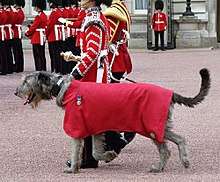
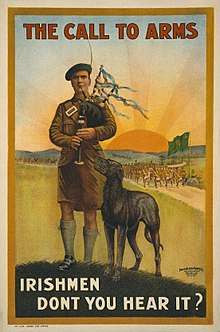
Hunting dogs were coveted and were frequently given as gifts to important personages and foreign nobles. King John of England, in about 1210, presented an Irish hound named Gelert to Llywelyn, the Prince of Wales. The poet The Hon William Robert Spencer immortalized this hound in a poem.[17]
In his Historie of Ireland completed 1571, Edmund Campion gives a description of the hounds used for hunting wolves in the Dublin and Wicklow mountains. He says: "They (the Irish) are not without wolves and greyhounds to hunt them, bigger of bone and limb than a colt". Due to their popularity overseas many were exported to European royal houses leaving numbers in Ireland depleted. This led to a declaration by Oliver Cromwell being published in Kilkenny on 27 April 1652 to ensure that sufficient numbers remained to control the wolf population.[21][22]
The early 18th century engraving (see picture) from Entwurf einiger Thiere by Johann Elias Ridinger is the oldest known image of the original wolfhound.[12] References to the Irish Wolfhound in the 18th century tell of its great size, strength and greyhound shape as well as its scarcity. Writing in 1790, Bewick described it as the largest and most beautiful of the dog kind; about 36 inches high, generally of a white or cinnamon colour, somewhat like the Greyhound but more robust. He said that their aspect was mild, disposition peaceful, and strength so great that in combat the Mastiff or Bulldog was far from being an equal to them.[23]
The last wolf in Ireland was killed in Co. Carlow in 1786.[23][24][25] It is thought to have been killed at Myshall, on the slopes of Mount Leinster, by a pack of wolfdogs kept by a Mr Watson of Ballydarton. The wolfhounds that remained in the hands of a few families, who were mainly descendants of the old Irish chieftains, were now symbols of status rather than used as hunters, and these were said to be the last of their race.[23]
Thomas Pennant (1726–1798) reported that he could find no more than three wolfdogs when he visited Ireland. During the 1836 meeting of the Geological Society of Dublin, Dr. Scouler presented the "Notices of Animals which have disappeared from Ireland", with the wolfdog mentioned.[12]
Modern wolfhound

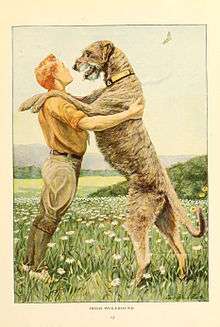
Captain George Augustus Graham (1833–1909) of Rednock House, Dursley, Gloucestershire was responsible for creating the modern Irish wolfhound breed. He stated that he could not find the breed "in its original integrity" to work with:
That we are in possession of the breed in its original integrity is not pretended; at the same time it is confidently believed that there are strains now existing that tracing back, more or less clearly, to the original breed; and it appears to be tolerably certain that our Deerhound is descended from that noble animal, and gives us a fair idea of what he was, though undoubtedly considerably his inferior in size and power.
— Captain G. A. Graham[26]
Based on the writings of others, Graham had formed the opinion that a dog resembling the original wolfhound could be recreated through using the biggest and best examples of the Scottish Deerhound and the Great Dane, two breeds which he believed had been derived earlier from the wolfhound.[27] Into the mix went the Scottish Deerhound, the Great Dane, and Kathleen Pelham-Clinton, Duchess of Newcastle's Borzoi "Korotai", who had proved his wolf hunting abilities earlier in his native Russia. For an outbreed a "huge shaggy dog" was added, which may have possibly been a Tibetan Mastiff.[12]
The famous English Mastiff "Garnier's Lion" was bred to the Deerhound "Lufra", and their offspring "Marquis" entered wolfhound pedigrees through his granddaughter "Young Donagh". Graham included "a single outcross of Tibetan Wolf Dog".[28] This was long assumed to have been a Tibetan Mastiff. However, a photograph of "Wolf" shows a bearded, long-coated dog—what would now be called a Tibetan kyi apso. In 1885 Captain Graham with other breeders founded the Irish Wolfhound Club, and the Breed Standard of Points to establish and agree the ideal to which breeders should aspire.[21][29]
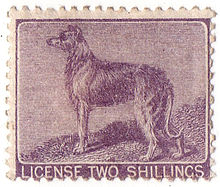
The Wolfhound has been adopted as a symbol by both rugby codes. The national rugby league team is nicknamed the Wolfhounds, and the Irish Rugby Football Union, which governs rugby union, changed the name of the country's A (second-level) national team in that code to the Ireland Wolfhounds in 2010. One of the symbols that the tax authorities in both Ireland and Northern Ireland on their revenue stamps, have been the Irish wolfhound. In the video game Skyrim, the Irish Wolfhound is the breed of dog for all dogs in the base game.
DNA analysis
Genomic analysis indicates that although there has been some DNA sharing between the Irish wolfhound with the Deerhound, Whippet, and Greyhound, there has been significant sharing of DNA between the Irish Wolfhound with the Great Dane.[30] One writer has stated that for the Irish Wolfhound, "the Great Dane appearance is strongly marked too prominently before the 20th Century".[12] George Augustus Graham created the modern Irish wolfhound breed that retained the appearance of the original form but not its genetic ancestry.[24]
Appearance
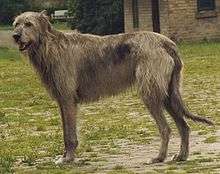
Considered by the American Kennel Club to be the tallest of all dog breeds, describing the breed as, "of great size and commanding appearance, the Irish Wolfhound is remarkable in combining power and swiftness with keen sight. The largest and tallest of the galloping hounds, in general type he is a rough-coated, Greyhound-like breed; very muscular, strong though gracefully built; movements easy and active; head and neck carried high, the tail carried with an upward sweep with a slight curve towards the extremity".[31] The average height of an Irish Wolfhound should be taller than that of a Great Dane. However, the wolfhound is not to be confused with being the heaviest, as its structure should be similar to that of a Greyhound, with a very broad and deep chest that tucks up.
Its colour may be grey, brindle, red, black, white, fawn, and wheaten.[32]
The Irish Wolfhound was bred for long solitary hunts based solely on the dog's ability to visualize its landscape and perceive, unlike scent hounds (such as Bloodhounds and Beagles) who rely on scent rather than sight. For this reason, the neck of an Irish Wolfhound should be long with the head held high the majority of the time. The Irish Wolfhound should also appear to be longer than it is tall.[33] Once used to hunt wolves, an Irish Wolfhound's structure should appear as if it is “fast enough to catch a wolf, and strong enough to kill it”.[34]
The AKC specifies the minimum height as 32 inches (81 cm) for mature males, 30 inches (76 cm) for females; the minimum weight: 120 pounds (54 kg) for males, 105 pounds (48 kg) for females.[31] It is not rare to see modern day female hounds reaching the minimal height requirements of those of male hounds; most females are well over 30 inches (76 cm)[35] and in most AKC conformation shows a wolfhound's height is looked at with as much importance as the hound's head and face structure.[36] Per the AKC, great size, including height of shoulder and proportionate length of body is to be aimed at, to firmly establish a breed averaging 32–34 inches (81–86 cm) in males.[31] The height/weight standards in Ireland and England are slightly different: males 79 centimetres (31 in)/54.5 kilograms (120 lb), females 71 centimetres (28 in)/40.9 kilograms (90 lb).[37]
Temperament
Irish Wolfhounds have a varied range of personalities and are most often noted for their personal quirks and individualism.[38] An Irish Wolfhound, however, is rarely mindless, and despite its large size is rarely found to be destructive in the house or boisterous. This is because the breed is generally introverted, intelligent, and reserved in character. An easygoing animal, the Irish Wolfhound is quiet by nature. Wolfhounds often create a strong bond with their family and can become quite destructive or morose if left alone for long periods of time. An Irish Wolfhound is not a guard dog and will protect individuals rather than the house or the owner's possessions. However independent the wolfhound is, the breed becomes attached to both owners and other dogs they are raised with and is therefore not the most adaptable of breeds. Bred for independence, an Irish Wolfhound is not necessarily keen on defending spaces. A wolfhound is most easily described by its historical motto, “gentle when stroked, fierce when provoked”.[39] They should not be territorially aggressive to other domestic dogs but are born with specialized skills and it is common for hounds at play to course another dog. This is a specific hunting behavior, not a fighting or territorial domination behavior. Most Wolfhounds are very gentle with children. The Irish Wolfhound is relatively easy to train. They respond well to firm, but gentle, consistent leadership. However, historically these dogs were required to work at great distances from their masters and think independently when hunting rather than waiting for detailed commands and this can still be seen in the breed.[40]
Irish Wolfhounds are often favored for their loyalty, affection, patience and devotion. Although at some points in history they have been used as watchdogs, unlike some breeds, the Irish Wolfhound is usually unreliable in this role as they are often friendly toward strangers, although their size can be a natural deterrent. However, when protection is required this dog is never found wanting. When they or their family are in any perceived danger they display a fearless nature. Author and Irish Wolfhound breeder Linda Glover believes the dogs' close affinity with humans makes them acutely aware and sensitive to ill will or malicious intentions leading to their excelling as a guardian rather than guard dog.[41]
Health
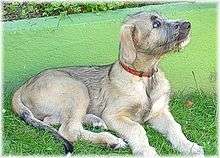
Like many large dog breeds, Irish Wolfhounds have a relatively short lifespan. Published lifespan estimations vary between 6 and 10 years with 7 years being the average. Dilated cardiomyopathy and bone cancer are the leading cause of death and like all deep-chested dogs, gastric torsion (bloat) is common; the breed is affected by hereditary intrahepatic portosystemic shunt.[42]
In a privately funded study conducted under the auspices of the Irish Wolfhound Club of America and based on an owner survey, Irish Wolfhounds in the United States from 1966 to 1986 lived to a mean age of 6.47 and died most frequently of bone cancer.[43] A more recent study by the UK Kennel Club puts the average age of death at 7 years.[44]
Studies have shown that neutering is associated with a higher risk of bone cancer in various breeds,[45][46][47] with one study suggesting that castration of male Irish Wolfhounds should be avoided at least until the dog is fully grown.[42]
Irish Wolfhounds should not receive additional supplements when a good dog food is used. It is generally accepted that they should be fed a low protein adult dog food (19 to 21% protein) from puppyhood onward. Most breeders today recommend that they not be supplemented to slow their rapid growth.[48]
Irish Wolfhounds are the tallest of all dog breeds.They are well suited to rural life, but their medium energy profile allows them to adjust fairly well to suburban and urban life as well, provided they receive appropriate exercise.
References
- "Irish Wolfhound Dog Breed". hillspet.
- "Irish Wolfhound". dogtime.com. Retrieved 24 January 2020.
- "Irish Wolfhound". easypetmd.com. Retrieved 24 January 2020.
- DeQuoy, A. W. (1971). The Irish Wolfhound in Irish literature and law.
- Scharff, R. F. (1924). "On the breeds of dogs peculiar to Ireland and their origin". The Irish Naturalist. 33 (8): 77–88.
- Hogan, E. I. (1897). The History of the Irish Wolfdog. Privately reprinted for JA McAleenan.
- Shaw, Vero (1878–1881). The Illustrated Book Of The Dog. London.
- Shaw, Vero (1878–1881). The Illustrated Book Of The Dog. London. pp. 204–218.
- Parker; et al. (2017). "Genomic Analyses Reveal the Influence of Geographic Origin, Migration, and Hybridization on Modern Dog Breed Development". Cell Reports. 19 (4): 697–708. doi:10.1016/j.celrep.2017.03.079. PMC 5492993. PMID 28445722.
- Almirall, L. V. (1941). Canines and Coyotes. Caxton printers, Limited.
- Copold, S. (1977). Hounds, Hares & Other Creatures: The Complete Book of Coursing. Donald R. Hoflin. OCLC 3071190.
- Gordon, John F. (1973). "1". The Irish wolfhound (Bartholomew breed guides ed.). J. Bartholomew, Edinburgh. pp. 1–7. ISBN 0851529186.
- Samaha(1991)p.2.
- Duffy, Seán. Medieval Ireland: An Encyclopedia. Routledge, 2005. p.698
- Arrian; Dansey, W. (1831). Arrian on coursing : the Cynegeticus of the younger Xenophon, translated from the Greek, with classical and practical annotations, and a brief sketch of the life and writings of the author. To which is added an appendix, containing some account of the Canes venatici of classical antiquity. Bohne. pp. 297.
- “wolfhound” An Bunachar Náisiúinta Téarmaíochta don Ghaeilge/The National Terminology Database for Irish
- McBryde, Mary (1998). The Irish Wolfhound: Symbol of Celtic Splendor. John Wiley & Sons. p. 19. ISBN 978-0-87605-169-6.
- cú in Ó Dónaill, Niall (1977). Foclóir Gaeilge-Béarla. Dublin: Richview Browne & Nolan Ltd. ISBN 1-85791-038-9.
- faol in Ó Dónaill, Niall (1977). Foclóir Gaeilge-Béarla. Dublin: Richview Browne & Nolan Ltd. ISBN 1-85791-038-9.
- McCormick, F. (1991). "The Dog in Prehistoric and Early Christian Ireland". Archaeology Ireland. 5 (4): 7–9. JSTOR 20558375.
- Howell, Elsworth S. (1971). The International Encyclopedia of Dogs. McGraw-Hill. pp. 254–255. ISBN 978-0-7015-2969-7.
- McBryde, Mary (1998). The Irish Wolfhound: Symbol of Celtic Splendor. John Wiley & Sons. pp. 24–25. ISBN 978-0-87605-169-6.
- McBryde, Mary (1998). The Irish Wolfhound: Symbol of Celtic Splendor. John Wiley & Sons. pp. 27–31. ISBN 978-0-87605-169-6.
- Larson, G.; Karlsson, E. K.; Perri, A.; Webster, M. T.; Ho, S. Y. W.; Peters, J.; Stahl, P. W.; Piper, P. J.; Lingaas, F.; Fredholm, M.; Comstock, K. E.; Modiano, J. F.; Schelling, C.; Agoulnik, A. I.; Leegwater, P. A.; Dobney, K.; Vigne, J.-D.; Vila, C.; Andersson, L.; Lindblad-Toh, K. (2012). "Rethinking dog domestication by integrating genetics, archeology, and biogeography". Proceedings of the National Academy of Sciences. 109 (23): 8878–8883. Bibcode:2012PNAS..109.8878L. doi:10.1073/pnas.1203005109. PMC 3384140. PMID 22615366.
- Hickey, Kieran R. "A Geographical Perspective on the Decline and Extermination of the Irish Wolf canis lupus" (PDF). Department of Geography, National University of Ireland, Galway. Archived from the original (PDF) on 7 September 2012. Retrieved 12 September 2007. Cite journal requires
|journal=(help) - Graham, G. A. (1885). The Irish Wolfhound. Whitmore & Son. pp. 1.
- Graham, G. A. (1885). The Irish Wolfhound. Whitmore & Son. pp. 23. Do a search on these two breeds, this is the subject of the book.
- Hamilton, Ferelith editor (1971). The World Encyclopedia of Dogs. New York and Cleveland: The World Publishing Company. p. 672.
- Samaha(1991)pp.8-19.
- Parker, Heidi G.; Dreger, Dayna L.; Rimbault, Maud; Davis, Brian W.; Mullen, Alexandra B.; Carpintero-Ramirez, Gretchen; Ostrander, Elaine A. (2017). "Genomic Analyses Reveal the Influence of Geographic Origin, Migration, and Hybridization on Modern Dog Breed Development". Cell Reports. 19 (4): 697–708. doi:10.1016/j.celrep.2017.03.079. PMC 5492993. PMID 28445722. Refer Figure 4 and Supplementary Table S2: "Mean Haplotype Sharing Totals that Reach the 95% Significance Level between All Pairs of Breeds"
- "Irish Wolfhound". American Kennel Club. Retrieved 30 January 2019.
- "Irish Wolfhound Breed Standard". American Kennel Club.
- McBryde, Mary (1998). The Irish Wolfhound: Symbol of Celtic Splendor. John Wiley & Sons. pp. 107–132. ISBN 978-0-87605-169-6.
- Samaha, Joel (3 May 2019). "Judging Irish Wolfhounds - A Guide". Irish Wolfhound Club of America. Retrieved 3 May 2019.
- McBryde, Mary (1998). The Irish Wolfhound: Symbol of Celtic Splendor. John Wiley & Sons. p. 112. ISBN 978-0-87605-169-6.
- Thomasson, Lois J. (January 2003). "Judging by Points". Cite journal requires
|journal=(help) - The Kennel Club. "Irish Wolfhound Breed Standard". Retrieved 30 January 2019.
- McBryde, Mary (1998). The Irish Wolfhound: Symbol of Celtic Splendor. John Wiley & Sons. p. 15. ISBN 978-0-87605-169-6.
- McBryde, Mary (1998). The Irish Wolfhound: Symbol of Celtic Splendor. John Wiley & Sons. p. 14. ISBN 978-0-87605-169-6.
- McBryde, Mary (1998). The Irish Wolfhound: Symbol of Celtic Splendor. John Wiley & Sons. pp. 97, 160–162. ISBN 978-0-87605-169-6.
- Glover, Linda (1999). Irish wolfhound (World of Dogs). TFH. ISBN 978-1-85279-077-6.
- Urfer SR, Gaillard C, Steiger, A (2007). "Lifespan and disease predispositions in the Irish wolfhound: a review" (PDF). Vet Q. 29 (3): 102–111. doi:10.1080/01652176.2007.9695233. PMID 17970287. Archived from the original (PDF) on 26 July 2007. Retrieved 15 December 2008.CS1 maint: multiple names: authors list (link)
- Bernardi, Gretchen (1997). "Longevity and Morbidity in the Irish Wolfhound in the United States - 1966 to 1986". Irish Wolfhound Club of America. Retrieved 3 May 2019.
- "Summary results of the Purebred Dog Health Survey for Irish Wolfhound" (PDF). Kennel Club/British Small Animal Veterinary Association Scientific Committee. 2004. Retrieved 30 January 2019.
- Priester; McKay, F. W. (1980). "The Occurrence of Tumors in Domestic Animals". Journal of the National Cancer Institute (54): 1–210. PMID 7254313.
- Ru, G.; Terracini, B.; Glickman, L. (1998). "Host related risk factors for canine osteosarcoma". The Veterinary Journal. 156 (1): 31–9. doi:10.1016/S1090-0233(98)80059-2. PMID 9691849.
- Cooley, D. M., Beranek, B. C.; et al. (1 November 2002). "Endogenous gonadal hormone exposure and bone sarcoma risk". Cancer Epidemiology, Biomarkers & Prevention. 11 (11): 1434–40. PMID 12433723.CS1 maint: multiple names: authors list (link)
- https://heartoftexasirishwolfhounds.weebly.com/irish-wolfhound-health.html
Further reading
- McBryde, Mary (1998). The Irish Wolfhound: Symbol of Celtic Splendor. John Wiley & Sons. ISBN 978-0-87605-169-6.
- Samaha, Joel (1991). The New Complete Irish Wolfhound. Howell Book House. ISBN 978-0-87605-171-9.
- Landau, Elaine (2011). Irish Wolfhounds Are The Best. Lerner Publishing Group. ISBN 978-0-7613-6081-0.